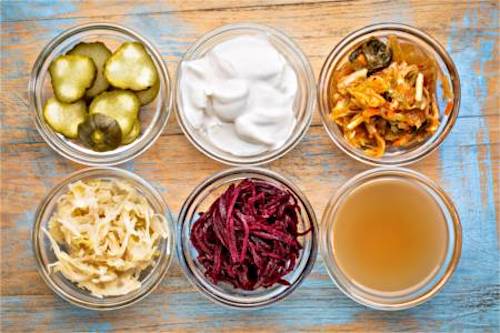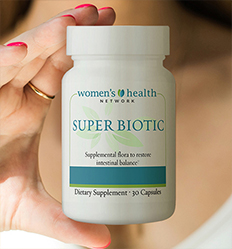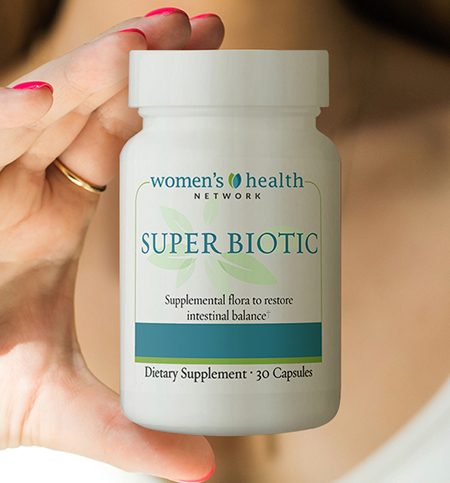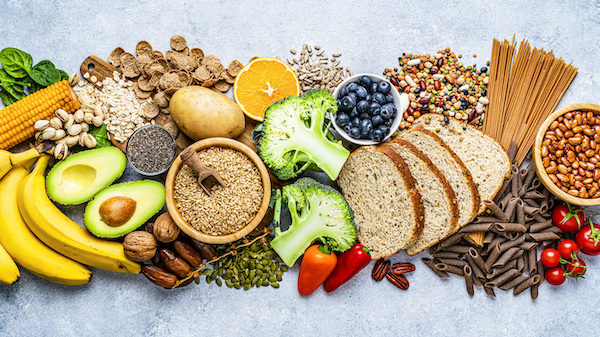I take a probiotic supplement every day and always recommend one to my clients. But as a nutritionist — and someone who loves to eat — I naturally add food ideas to help my clients get more healthy bacteria in their diet. And those ideas go way beyond yogurt or sauerkraut.

You should try this approach too. Every day we get more proof of the importance of friendly bacteria to our health. And not just for our digestive health — they’re proving vital to oral health, breast health, heart health and more. So it just makes sense to give your body what it needs to thrive.
Here are my five favorite steps to get more probiotic power:
1. Every day, add one fermented food to your diet.
You’ve got a lot of good choices, so mix them up!
- apple cider vinegar
- aged cheeses like Gouda, Swiss or cheddar
- brined green olives
- sauerkraut
- fresh green peas
- homemade pickles
- dark chocolate
- kimchi
- miso
- tempeh
And for those who have trouble with dairy foods, consider trying kefir. It’s a lot less irritating to a dairy-sensitive stomach than standard yogurt, but with the same or greater probiotic benefits. In some areas you can even get goat’s milk kefir.
2. Mix it up to stay on track.
Adding in new foods can sound easy enough, but many people find it’s not so simple.
If you’re turned off by the idea of eating miso soup every day, my tip is to not always focus on probiotic foods as a main course. They work just as well as sides, condiments or beverages. Here are some ideas:
- Miso or apple cider vinegar can work perfectly well as salad dressing for greens
- Use brined olives to add a salty accent to Mediterranean-style fish or poultry dishes
- Kimchi can spice up scrambled eggs
- Pickles or sauerkraut can be added into a wrap
- Kefir or yogurt work well as the foundation for a smoothie
The opportunities for experimentation with probiotic foods are endless. And, you don’t have to eat a lot to get the benefit.
3. Add prebiotics for better results.
Give your friendly bacteria the “food” they need in the form of prebiotics — indigestible plant fiber compounds, such as inulins and fructo-oligosaccharides.
Adding prebiotics to your diet is like scattering seeds in a garden. It’s a first step to ensuring something blooms, but you’ll get better results if you make sure that what you’re trying to grow has what it needs to thrive.
You can get prebiotics from:
- asparagus
- bananas
- chickpeas
- Jerusalem artichoke
- garlic
- leeks and onions
- lentils and other legumes
- whole grains
- cruciferous vegetables such as broccoli, Brussels sprouts, cabbage, cauliflower, collard greens and kale
4. Avoid unnecessary use of antibiotics, sugar and high glycemic foods.
Antibiotics can be great in treating serious bacterial infections. But they kill the good along with the bad, and we’re exposed to them unintentionally when we eat conventionally raised chicken and beef — so choose organic meats when you can. Sugar and high-carbohydrate diets tend to increase the acidity in the gastrointestinal tract, which can also suppress the good bacteria’s ability to become established.
5. Don’t overdo it (or give up).
As with everything, it’s possible to get overly enthusiastic when it comes to probiotics and prebiotics. Listen to your body, particularly if you already have gastrointestinal issues — which many of us do by this stage of our lives!
This is especially true if you’re adding a lot of fiber-rich foods such as legumes or broccoli, which are rich in inulin but can sometimes lead to gas and bloating. So if you’re having a reaction to your new diet, I suggest you try scaling back to adding a probiotic food into your diet every 2 to 3 days rather than daily. You can add more over time.
If even small amounts of probiotic or prebiotic foods cause tremendous stomach trouble, or if you already have gastrointestinal issues, just stick to a high-quality probiotic supplement for a while. Look for one that offers a variety of organisms from genera like Lactobacillus and Bifidobacteria. Take it with food to limit the effects of stomach acid on the organisms. You need friendly bacteria for your health – and not just in your gut!
- Ray R.C., Montet D. (eds). Fermented Foods: Part II, Technological Interventions. CRC Press, Boca Raton, FL.
- Tran J., Wilson K., Plebanski M., Flanagan K.L. Manipulating the microbiota to improve human health throughout life. Trans Roy Soc Trop Med Hygiene. 2017; https://doi.org/10.1093/trstmh/trx068. https://academic.oup.com/trstmh/advance-article/doi/10.1093/trstmh/trx068/4735135.
- Dwivedi S., Sahrawat K., Puppala N., Ortiz R. Plant prebiotics and human health: Biotechnology to breed prebiotic-rich nutritious food crops. Electron. J. Biotechnol. 2014; 17(5). https://dx.doi.org/10.1016/j.ejbt.2014.07.004.
 | See how probiotics can help with weight loss, improved mood and reduced allergies with our article New and surprising benefits of probiotics. |











